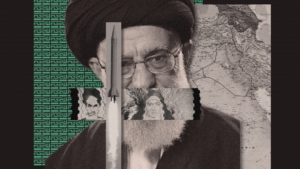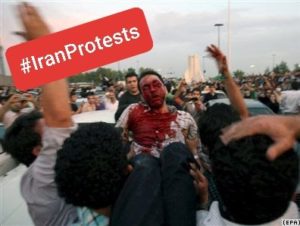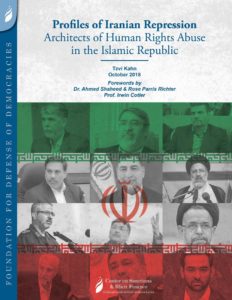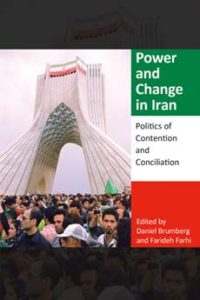There have been fresh protests in Tehran more than three days after the Iranian authorities admitted they accidentally shot down a Ukrainian airliner on January 8, killing 176 people, RFE/RL’s Radio Farda reports. Meanwhile, in a televised speech, Iranian President Hassan Rohani called for a special court to be set up to investigate the tragedy and promised that those responsible would pay. Social-media videos (above) were vetted by Radio Farda, but their authenticity could not be independently verified.
Iran’s admission that it mistakenly shot down a passenger plane sent protesters pouring into the streets over the weekend. Though demonstrations were smaller on Monday and nearly outnumbered by riot police, some observers have already begun to wonder if this could be the beginning of the end for the current regime, CNN reports.

CSIS
This reckoning is already being billed as Iran’s “Chernobyl” moment, an analogy to the way the 1986 nuclear disaster in the Soviet Ukraine “exposed all the incompetence, state deception and rot in that regime,” according to IranWire, a site for Iranian citizen journalists in the diaspora.”
Demands for government resignations spread Monday from hard-liners, who support Iran’s clerical government and called for officials to step down over the weekend, to members of the more moderate reformist parties, President Hassan Rouhani’s base, The New York Times adds:
Ali Shakouri Rad, the head of a reformist political party, said the growing rift between the public and the clerical government had become insurmountable. “Covering up the mistake of downing the passenger jet with missiles was throwing acid at the image of the Islamic Republic,” he said on Twitter.
The U.S. is pursuing a strategy of regime disruption devised by David Wurmser, a former consultant to the National Security Council, who argues that Iran is in the midst of a legitimacy crisis. Its leadership, he writes, is divided between camps that seek an apocalyptic return of the hidden imam, and those that favor the preservation of the Islamic Republic founded in 1979. All the while, many Iranians have grown disgusted with the regime’s incompetence and corruption, Bloomberg’s Eli Lake reports.
 “Iran has always been careful to execute its ambitions and aggressive aims incrementally to avoid Western reactions which depart from the expected,” Wurmser argues. “In contrast, were unexpected, rule-changing actions taken against Iran, it would confuse the regime. It would need to scramble,” he writes. Such a U.S. attack would “rattle the delicate internal balance of forces and the control over them upon which the regime depends for stability and survival.”
“Iran has always been careful to execute its ambitions and aggressive aims incrementally to avoid Western reactions which depart from the expected,” Wurmser argues. “In contrast, were unexpected, rule-changing actions taken against Iran, it would confuse the regime. It would need to scramble,” he writes. Such a U.S. attack would “rattle the delicate internal balance of forces and the control over them upon which the regime depends for stability and survival.”
But external actors may be underestimating the regime’s resilience, some analysts suggest.
“Through a western lens, we’re always looking for a revolutionary moment [in Iran],” said Sanam Vakil, a senior research fellow and leader of the Iran Forum at London-based think tank Chatham House.
While there are certainly similarities between how authorities handled the Chernobyl accident and the downing of Ukraine International Airlines Flight 752 — repeated denials, attempted cover-ups, inescapable evidence from foreign governments, and a reluctant admission — the parallels may end there, she said.
 “This could be ‘Iran’s Chernobyl moment,'” Vakil told CNN. “But the question is how is Iranian leadership going to handle it. [After Chernobyl] everything was very much incumbent on one political leader making a decision to accept responsibility and alter political dynamics.”
“This could be ‘Iran’s Chernobyl moment,'” Vakil told CNN. “But the question is how is Iranian leadership going to handle it. [After Chernobyl] everything was very much incumbent on one political leader making a decision to accept responsibility and alter political dynamics.”
Domestic political considerations will determine the regime’s response to the current spate of protests, observers suggest.
“The Guardian Council just disqualified many moderate and reformist candidates who had registered to run for the 21 February parliamentary elections, meaning that hard line voices are likely to dominate the new parliament,” notes Mahsa Rouhi, Research Fellow at the International Institute for Strategic Studies (IISS). “The state’s securitised reaction to the protests is a further indication that it is unlikely to show flexibility and tolerance in addressing this polarisation of opinions.”
Regime reaction
“How the regime reacts will be more than usually interesting,” said John Raine, Senior Adviser for Geopolitical Due Diligence at IISS. “So far the concerned reaction from the top suggests they may realise that more may be at stake for the IRGC than its reputation. If, as it seems, they are ruling out the use of force, they will have to come up with an alternative means of containing the demonstrations quickly if they are to regain the initiative.”
 As a recent study of the December fuel protests shows, “economic grievances were likelier to inspire protest in areas where frustration with the whole system was endemic… Economic hardship turned frustrations with the system into assertive protest activities,” analyst The protests appear to have comprised largely of individuals newly confronting economic hardship, which suggests the emergence of a precariat class in Iran. Just last year, 1.6 million Iranians fell into poverty due to high inflation.
As a recent study of the December fuel protests shows, “economic grievances were likelier to inspire protest in areas where frustration with the whole system was endemic… Economic hardship turned frustrations with the system into assertive protest activities,” analyst The protests appear to have comprised largely of individuals newly confronting economic hardship, which suggests the emergence of a precariat class in Iran. Just last year, 1.6 million Iranians fell into poverty due to high inflation.
Despite the discontent, it remains unclear whether the protests represent an existential threat to the regime, reports suggest.
“We are seeing Iran’s population of over 80 million growing increasingly polarized and frustrated based on various issues. Some over the economy, others over corruption, lack of political freedoms, Soleimani’s assassination, and mismanagement across most branches of government and military,” said Ellie Geranmayeh, an Iran expert at the European Council on Foreign Relations. “The support base for the Islamic Republic is getting smaller and more segments of Iran’s population are questioning the legitimacy of its leaders —but nevertheless the support for the ruling elite remains powerful enough (no matter its shrinking size) to maintain its survival.”
 Beijing wants to preserve the status quo in Iran, according to Jude Blanchette, the Freeman Chair in China Studies at the Center for Strategic and International Studies (CSIS), and Bonnie Glaser, senior adviser for Asia and director of the China Power Project at CSIS:
Beijing wants to preserve the status quo in Iran, according to Jude Blanchette, the Freeman Chair in China Studies at the Center for Strategic and International Studies (CSIS), and Bonnie Glaser, senior adviser for Asia and director of the China Power Project at CSIS:
Any interruption to this supply, even one stemming from a U.S. intervention in the region, would be extraordinarily costly for China in the short run. As our colleague Jon Alterman said in a recent congressional testimony, “The region’s chokepoints—the Strait of Hormuz, the Bab al-Mandeb, and the Suez Canal—are China’s chokepoints.” …..There are more than just energy supplies at stake for China. Currently, an estimated half million Chinese citizens live and work in the Middle East, and as a People’s Liberation Army-led effort to evacuate nearly 35,000 civilians from Libya in 2011 demonstrated, the logistical realities of an expanding overseas footprint are considerable. Add to this China’s growing investment portfolio in the region, with more than $23 billion in loans and aid pledged to the region in 2018 and $28 billion in investment. RTWT







